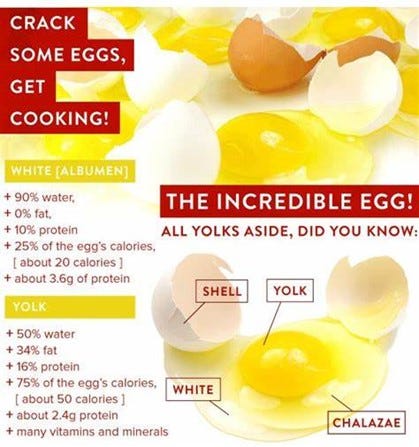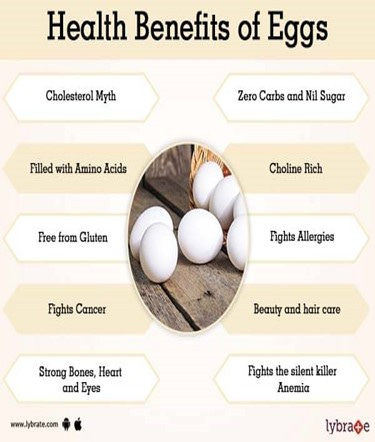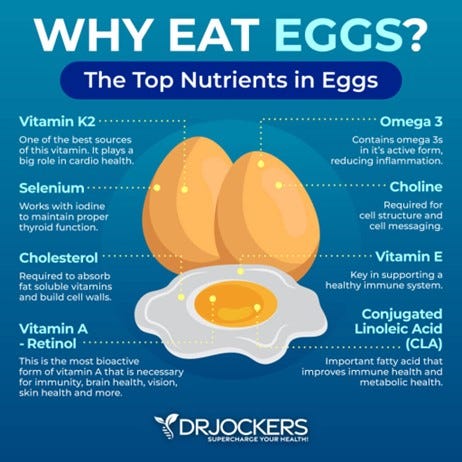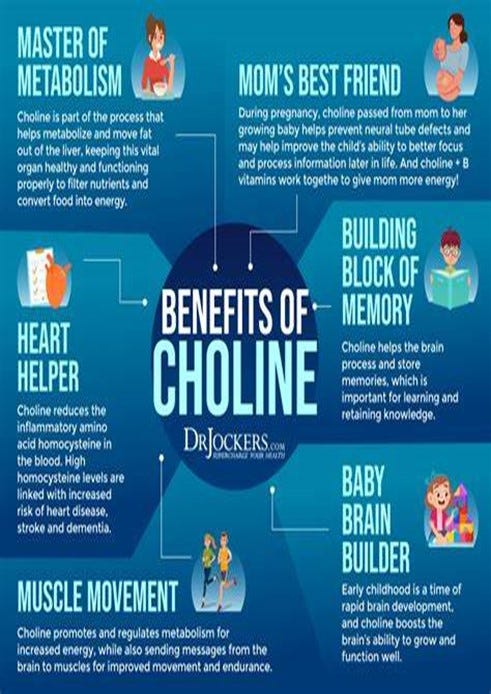Eggs have been much vilified by the mainstream media, which on its face should be enough to make you suspect that they have many health benefits, and you would be correct. Eggs are a superfood and wonderful for your health. Let us take a deep dive this week into eggs and why they should be part of your diet.
If you have been reading my Substack for any length of time, you know foremost that I like to teach my readers about the science of any subject I am exploring. Towards that goal, let us look at “everything egg”.
There are many types of eggs, but for the most part Americans eat chicken eggs. So, for the purposes of this article, I will be referring primarily to chicken eggs.
WHAT DO THE DIFFERENT EGG SIZES MEAN?
The USDA has established standards for egg sizes in the United States. These standards are based on the minimum required weight per dozen eggs. The following are the USDA standards for egg sizes, listed from largest to smallest:
JUMBO EGGS
Minimum 30 ounces (850 grams) per dozen. Jumbo eggs are the largest commercially available eggs. They usually weigh around 70 grams (2.5 ounces) or more. These eggs are often sought after by those who prefer a larger yolk-to-white ratio and are commonly used for baking or in recipes that require a larger amount of egg.
EXTRA-LARGE EGGS
Minimum 27 ounces (765 grams) per dozen. Extra-large eggs are slightly smaller than jumbo eggs. They typically weigh between 63 to 69 grams (2.2 to 2.5 ounces). Extra-large eggs are popular for their versatile use in both cooking and baking.
LARGE EGGS
Minimum 24 ounces (680 grams) per dozen. Large eggs are the most sold eggs in grocery stores. They have a weight range of about 56 to 62 grams (2 to 2.2 ounces). Large eggs are widely used in various culinary applications including frying, scrambling, baking, and as a general ingredient in recipes.
MEDIUM EGGS
Minimum 21 ounces (595 grams) per dozen. Medium eggs weigh around 50 to 55 grams (1.8 to 1.9 ounces) each. While less common than large eggs, medium eggs can still be found in supermarkets and are suitable for most cooking and baking purposes.
SMALL EGGS
Minimum 18 ounces (510 grams) per dozen. Small typically weigh around 43 to 49 grams (1.5 to 1.7 ounces). They may be less commonly available in stores but can still be used for cooking and baking, especially when recipes call for smaller amounts of egg.
PEEWEE
Minimum 15 ounces (425 grams) per dozen. Peewee eggs are the smallest commercially available eggs. They typically weigh around 35 to 42 grams (1.2 to 1.5 ounces). These eggs are much less common and may not be widely available. They are primarily used in specialized culinary applications or in recipes that require smaller portions.
WHAT DOES THE DIFFERENT TYPE OF EGG GRADES MEAN?
In the United States, eggs are commonly graded based on their quality and appearance. The grading process evaluates factors such as shell cleanliness, thickness, and texture, as well as the quality of the yolk and albumen (egg white). There are three main grades of eggs commonly used in the United States: AA EGGS, A EGGS AND B EGGS
THE ANATOMY OF AN EGG
Egg anatomy is quite simple, but important for us to better understand the nutrition provided by the different egg components.
As you can readily see from reading the above chart, eggs are a nutritional powerhouse, not the demons the mainstream media would have you think.
Kinky Facts/Nerd Food: I know this is the burning question on all your minds: Why Did Dr. Seuss write Green Eggs and Ham?
Incredibly, Dr. Seuss wrote Green Eggs and Ham on a 50-dollar bet from a friend who said he could not write a children’s book only using fifty words! My inner nerd just loves this kind of stuff, LOL. However, I digress, now back to eggs!
EGG TYPES BASED ON HOW THEY ARE COOKED
As you know, there are many ways to cook eggs and each of us has our preferences. I particularly love sunny side up eggs with nice runny yolks to dunk my well done sunflower or rye toast into………. yummy! That being said, I also love hard boiled eggs with some salt on them.
The preparation of eggs is beyond the scope of this article, so I will only touch on it briefly. Here are the main ways to prepare your eggs:
Hard boiled and soft-boiled eggs: Both hard-boiled and soft-boiled eggs offer similar nutrition. Soft-boiled eggs may retain more nutrients, while hard-boiled eggs are convenient for storage and snacking.
The one health consideration to possibly keep in mind is that soft-boiled eggs are not fully cooked. There is a risk of possible salmonella poisoning. The Centers for Disease Control and Prevention (CDC) and the Food and Drug Administration (FDA) both highlight the dangers of Salmonella, a common cause of food poisoning that can be found in eggs not cooked thoroughly.
The symptoms of Salmonella infection include diarrhea, fever, abdominal cramps, and vomiting, appearing 12 to 72 hours after eating contaminated food.
NOTE: To kill salmonella bacteria in eggs, you can cook them using the following methods and temperatures:
Boiling water: 212°F (100°C) for 60 minutes
Stir-frying: 320°F (160°C) for 1 minute
Deep-frying: 350°F (175°C) for 30 seconds
Alternatively, you can fry eggs for 2 to 3 minutes on each side, or 4 minutes in a covered pan. Scrambled eggs should be cooked until firm throughout.
Ways to cook eggs:
Scrambled Eggs either Hard Scrambled or Soft Scrambled or Creamy Scrambled.
Omelets and Frittatas
Sunny Side Up, Over Easy, Over Medium, and Over Hard
Poached Eggs
This week’s Million Dollar Question is what is the difference between all the ways chickens are raised for egg production, and what does it mean for us?
How many times have you found yourself in a supermarket staring at the bewildering variety of egg types, not knowing which one is both the healthiest and the most humane way to raise chickens.
There is so much hype about different types of eggs, it is very confusing for consumers. Let’s clear up the confusion right now.
AMERICAN HUMANE CERTIFIED EGGS
American Humane Certified eggs are produced under the guidelines established by the American Humane Association. This certification ensures that the eggs come from hens that have been raised in a humane and compassionate manner with a focus on animal welfare.
CAGE-FREE EGGS
Cage-free eggs come from hens that are not confined to cages. Instead, they are typically housed in barns or other indoor facilities where they have more space to move around. It is important to note, however, that cage-free does not necessarily mean the hens have access to outdoor areas or a lot of space per bird. Don’t picture a coop with a dozen hens, but rather a large facility with thousands of birds.
FREE-RANGE EGGS
Free-range eggs come from chickens that have access to the outdoors in addition to indoor housing. They have more space to roam and engage in natural behaviors. Free-range eggs can be used in any recipe that calls for eggs, and some people believe they have a richer flavor due to the hens’ varied diets.
FREE-RUN EGGS
Free-run eggs come from chickens that are not confined to cages but are raised indoors. The hens have more space to move around, and they can exhibit natural behaviors like perching and nesting. These eggs can be used in the same way as standard eggs.
FURNISHED/ENRICHED/NEST-LAID EGGS
These eggs come from hens that are provided with additional amenities in their housing, such as perches, nests, or other enrichments. They are often marketed as having higher welfare standards. Their uses are like standard white or brown eggs.
OMEGA-3 EGGS
Omega-3 eggs come from hens that are fed a diet enriched with omega-3 fatty acids. As a result, the eggs contain higher levels of omega-3s, which are beneficial for heart health. They can be used in any recipe that calls for eggs.
ORGANIC EGGS
Organic eggs are produced by chickens that are raised according to specific organic farming standards. These hens are fed organic feed and are not treated with antibiotics or hormones. The eggs can be used in the same way as other types of eggs.
PASTEURIZED EGGS
Pasteurized eggs undergo a process called pasteurization, where they are heated to kill any potential bacteria, such as Salmonella, while retaining their nutritional value. Pasteurized eggs are often used in recipes that call for raw or undercooked eggs, providing an added layer of safety.
PASTURE-RAISED EGGS
Pasture-raised eggs come from hens that are raised on pastures or open fields. These hens have access to outdoor areas where they can roam, forage, and engage in natural behaviors.
Pasture-raised eggs are often considered to have higher welfare standards than cage-free eggs. Farmer’s markets are a good source for such eggs but expect to pay a premium to support farmers producing eggs this way.
PROCESSED EGGS
Processed eggs are eggs that have been modified or treated in some way. They can come in various forms such as liquid eggs, egg whites, or powdered eggs. These products are commonly used in the food industry for convenience and ease of use in large-scale food production.
STANDARD WHITE EGGS
This is the most common type of egg found in grocery stores. They come from chickens raised in conventional cages or indoor housing systems. They can be used in a variety of culinary preparations, such as baking, frying, boiling, or scrambling.
STANDARD BROWN EGG
Brown eggs are like white eggs in terms of their uses and culinary applications. The color difference is due to the breed of chicken that lays them, with brown eggs usually coming from larger breeds like Rhode Island Reds or Plymouth Rocks.
VEGETARIAN EGGS
Vegetarian eggs come from hens that are fed a vegetarian diet, which means they are not fed any animal by-products. They can be used in any recipe that calls for eggs and are suitable for individuals following a vegetarian diet.
VITAMIN-ENHANCED EGGS
Vitamin-enhanced eggs are produced by hens that are fed a diet supplemented with vitamins, such as vitamin E or D. These eggs can provide additional nutritional benefits, and their uses are like other types of eggs.
There are so many types of eggs available that it is somewhat mind boggling. My personal preference as a Functional Medicine doctor is always to go back to basics and see how chickens are raised in the most natural way, hence my personal preference is Pasture Raised Eggs.
Kinky Fact/Nerd Food: How to Tell If Your Eggs are Edible? What is Candling an Egg?
An old-fashioned but valid test for egg freshness is accomplished by gently dropping a whole uncooked egg into a salt solution (two tablespoons salt in two cups of water.) If very fresh, the egg will be full and heavy, and it will sink and tip to one side. If moderately fresh, it will remain suspended in the middle of the water upright; if it bobs up to the top, it is stale.
Shortly after an egg is laid, it is placed in front of a light source that reveals the condition of the innards. This process, called candling, can detect cracks in the shell or harmless but unappetizing blood spots on the yolk. It also reveals the size of the egg’s air cell: the smaller the cell, the better the egg.
DOES THE COLOR OF AN EGG SHELL MEAN ANYTHING?
Egg shell color doesn’t indicate nutritional advantages
Shutterstock
Blue, green, and brown eggs all look more unique and interesting than white eggs, but just because white eggs are lacking in color doesn’t mean they’re lacking in nutrition.
The difference in eggshell color is solely due to genetics. Therefore, if a blue egg-laying chicken is raised under the same conditions as a white egg-laying chicken, there will be no difference in nutrition or taste between the different colored eggs.
WHY THE MEDICAL UNDERGROUND RECOMMENDS EGGS
WHAT ARE THE HEALTH BENEFITS OF EATING EGGS?
Eggs, like so many traditional foods, have been vilified by the mainstream media as being unhealthy and dangerous, due to their cholesterol and fat content. Like most things we are told by them, and the government, is just more nonsense.
Eggs are a nutritional powerhouse and a very complete food that is not dangerous but in fact is quite healthy for us. Let’s look at why that is and why eggs are referred to as Natures Multivitamin!
Eggs are among the most nutritious foods on the planet. A whole egg contains all the nutrients required to turn a single cell into a baby chicken.
A single large, boiled egg contains:
Vitamin A: 8% of the DV (daily value)
Folate: 6% of the DV
Pantothenic acid (vitamin B5) : 14% of the DV
Vitamin B12: 23% of the DV
Riboflavin (vitamin B2) : 20% of the DV
Phosphorus: 7% of the DV
Selenium: 28% of the DV
Eggs also contain decent amounts of vitamin D, vitamin E, vitamin B6, calcium and zinc
This comes with 78 calories, 6 grams of protein and 5 grams of fat.
Eggs also contain various trace nutrients that are important for health.
In fact, eggs are pretty much the perfect food. They contain a little bit of almost every nutrient you need.
If you can get your hands on pastured or omega-3 enriched eggs, these are even more nutrient dense. They contain higher amounts of omega-3 fat and are much higher in vitamin A and E .
WHY THE MEDICAL UNDERGROUND LOVES CHOLINE
Egg Yolks are particularly rich in choline which is wonderful for your health and severely lacking in most Americans diet. Truth be told, I eat four egg yolks, bacon, toast and a large ice coffee most workdays (I don’t eat lunch) and this keeps me satiated for most of the day. Choline is beneficial in so many ways, especially for women during their pregnancies.
Choline is a nutrient that most people don’t even know exists, yet it is an incredibly important substance and is often grouped with the B vitamins.
Choline is used to build cell membranes and has a role in producing signaling molecules in the brain, along with various other functions.
Whole eggs are an excellent source of choline. A single egg contains more than 100 mg of this very important nutrient.
HIGH QUALITY PROTEIN AND ALL THE ESSENTIAL AMINO ACIDS IN THE CORRECT RATIOS
Proteins are the main building blocks of the human body. They’re used to make all sorts of tissues and molecules that serve both structural and functional purposes.
Getting enough protein in the diet is very important and studies show that currently recommended amounts may be too low.
Eggs are an excellent source of protein, with a single large egg containing six grams of it.
Eggs also contain all the essential amino acids in the right ratios, so your body is well-equipped to make full use of the protein in them. Remember amino acids are termed essential because it is essential that they are obtained in our diets since our bodies cannot produce them as they do the non-essential amino acids.
Eating enough protein can help with weight loss, increase muscle mass, lower blood pressure and optimize bone health, to name a few.
EGGS ARE WONDERFUL FOR YOUR EYES
Eggs contain lutein and zeaxanthin — antioxidants that have major benefits for eye health.
One of the consequences of aging is that eyesight tends to get worse. There are several nutrients that help counteract some of the degenerative processes that can affect our eyes.
Two of these are called lutein and zeaxanthin. They are powerful antioxidants that accumulate in the retina of the eye.
Studies show that consuming adequate amounts of these nutrients can significantly reduce the risk of cataracts and macular degeneration, two very common eye disorders.
Egg yolks contain large amounts of both lutein and zeaxanthin. In one older study, eating 1 egg daily for 5 weeks increased blood levels of lutein by 26% and zeaxanthin by 38% in older adults.
Eggs are also high in vitamin A, which deserves another mention here. Vitamin A deficiency is the most common cause of blindness in the world.
EGGS ARE HIGH IN CHOLESTEROL YET THIS IS USUALLY NOT A PROBLEM
Eggs are high in cholesterol, but don’t usually adversely affect blood cholesterol. Let’s see why.
It is true that eggs are high in cholesterol. In fact, a single egg contains 186 mg. However, it’s important to keep in mind that cholesterol in the diet may not necessarily have an impact on blood cholesterol levels or risk of heart disease.
The liver actually produces large amounts of cholesterol every single day. In fact, when you eat more cholesterol, your liver has the ability to regulate cholesterol levels by producing less to even it out.
Nevertheless, the response to eating eggs varies between individuals :
In 70% of people, eating cholesterol may not raise blood cholesterol or only mildly raise it (termed “hypo responders”)
In the other 30% of the population (termed “hyper responders”), eggs or other sources of dietary cholesterol may lead to a large rise in blood cholesterol.
Eating eggs consistently leads to elevated levels of HDL (the “good”) cholesterol, which has historically been linked to a lower risk of many diseases.
Egg consumption appears to change the pattern of LDL particles from small, dense LDL (bad) to large LDL, which is linked to a reduced heart disease risk. But more research is needed.
Omega-3 enriched and pastured eggs may contain significant amounts of omega-3 fatty acids. Eating these types of eggs is an effective way to reduce blood triglycerides.
However, people with genetic disorders like familial hypercholesterolemia or carriers of a gene variant called APOE4 may want to consider eating eggs in moderation.
If you have been my reader for a while or read any of my books, such as The Bible of Alternative Medicine, you know that I am not chewing my nails about high cholesterol levels, since it is such an essential nutrient for our vitamin and hormone production and hence our health.
I think the American public have been scammed for decades on the horrors of cholesterol and saturated fats and both are being debunked. Certainly, there is a subset of patients who need statin drugs, but they are a distinct minority.
I think the drugs used to reduce cholesterol have been wildly over prescribed and have dangerous side effects, However, as usual, I remain in the minority opinion among physicians! Hell, that is why I am in the Medical Underground!
BONUS: In these tumultuous times having food security is of primary importance. As many of you know, I began my writing career with my first book, The Doomsday Book of Medicine. Now, there is a title that will get your attention… LOL.
As you might imagine, it is a medical prepping book on how to treat every problem from head to toe without using prescription pharmaceuticals. I am proud to say that it is the go-to book for medical prepping.
However, I digress. What I was driving at originally about food security is that to do it right you have to do it on many levels, such as heirloom seed saving, gardening, canning and preserving food, fermenting food, and various ways of storing food. So, let us dive into how to save eggs for long term storage, something hardly anyone realizes can be done.
Most store-bought eggs are good for three to five weeks, but they can last up to 18 months and even years when properly preserved.
When you’re looking at how to store eggs long term, it’s essential to keep them in a cool, dry place — not on the countertop or in your refrigerator where moisture can accumulate.
The best place is usually your pantry or cabinet. You can also store them on the bottom shelf of your refrigerator as long as you cover the eggs with a lid or container, so they don’t pick up odors from other foods.
Here are a couple of the Medical Underground’s favorite ways to preserve eggs:
DEHYDRATING EGGS
Dehydrating eggs entails whisking them well until the yolks and whites are thoroughly combined, scrambling them, and leaving them on a dehydrator sheet to bake. For three dozen eggs, you’ll need to bake eggs for 18 hours at 145 degrees Fahrenheit until they become dry and flaky.
For those looking for ways on how to store eggs long term, dried eggs last longer than raw eggs: ten years for dried vs. three to five weeks for fresh eggs.
Image of water glassed eggs
WATER GLASSING EGGS
To use this method, you need to get very fresh eggs and do it immediately before the “bloom” wears off. The bloom is the last thing a hen does to an egg before she lays it. This provides a protective coat to the outside of the egg.
Most farmers who keep eggs for themselves leave this protective coating on the egg. It is a protective shield, covering all the pores so that bacteria and outside gases or chemicals cannot enter the egg while also trapping moisture inside the egg. The result is a full, rich egg with a bright orange yolk.
Water glassing is a centuries-old method of storing eggs. It involves preserving poultry eggs by storing them in a pickle lime solution. The pickle lime solution kills all microbes and assists in clogging the pores in its shell. This helps the eggs stay fresh for a long time. It is an easy-to-do, low-cost method and is efficient in preserving eggs.
To water glass eggs, you need to
Mix pickling lime and filtered water at a ratio of one ounce pickling lime to one quart of water.
Carefully place your clean, unwashed eggs into your jar or bucket.
Pour your pickling solution over the eggs.
Cover the container.
Label the container.
Store the container.
Distilled water or natural spring water are the best options for water glassing eggs. If your city adds fluoride to the water, boil the water and allow it to cool completely before using it. In a three-gallon bucket, add an equal ratio of water to lime. Five quarts water to five ounces of lime provides enough room for the eggs to be submerged.
Well, now that you have learned everything there is to know about eggs. You have just finished yet another exciting episode of the Medical Underground. If the topic of eggs ever comes up, you will astound your friends… LOL, Doc
I hope you found this episode on eggs both entertaining and educational, what better combo is there? If you are not currently a subscriber, please hit that prescribe button. If you are already a subscriber, please make my day and step up and become a paid subscriber. It costs less than a slice of pizza and a coke once a month and is a lot healthier for you!
Until we meet again, may God bless you and your family and the United States of America! For those of you who believe in Jesus Christ, remember this, for us: Miracle Shall Follow Miracle and Wonders Shall Never Cease!
This disclaimer provides that such medical information is merely information – not advice.
If users need medical advice, they should consult their doctor or other appropriate medical professional.
***Copyright © 2023-24 by Dr. Ralph La Guardia, MD
All rights reserved. This article or any portion thereof
may not be reproduced or used in any manner whatsoever
without the express written permission of the publisher
except for the use of brief quotations in an article review.





















Thanks DL, I try to write on subjects that are pertinent to my readers. Eggs are in all of our lives, like it or not. .LOL Doc
Excellent post; answers so many questions. 🙏